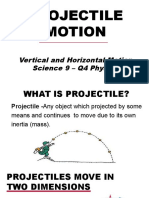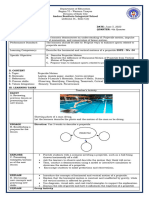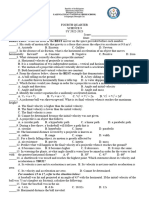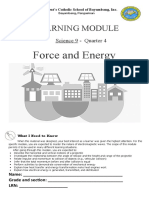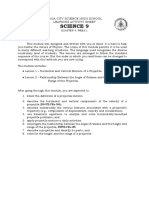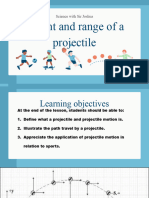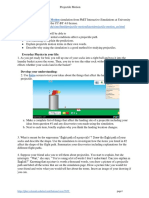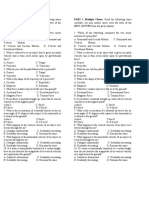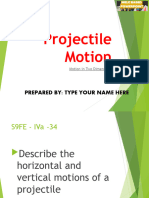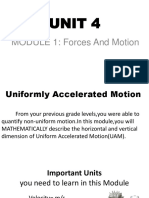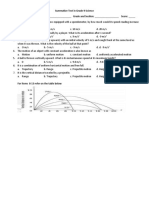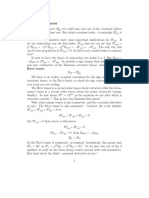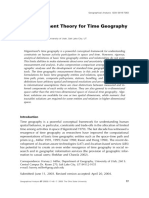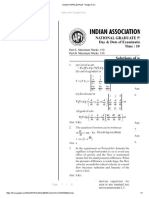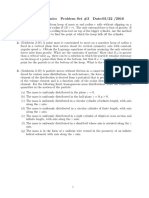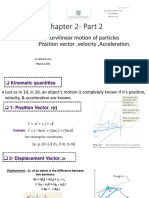Module 2
Lesson
Height and Range of a
1 Projectile
Most Essential Learning Competency:
1. Investigate the relationship between the angle of release and the height and range of
the projectile (S9FE-IVa-34).
WORD BANK
Scalar Quantity – physical quantity with only magnitude and no direction, examples are
distance, mass, speed, and time
Vector Quantity – physical quantity that has both magnitude and direction, examples are
displacement, acceleration, force, and velocity
Distance – total length of an actual path an object moved
Displacement – change in position of an object
Force - push or pull upon an object resulting from the object's interaction with another object
Speed – ratio of distance to the time in which the distance was covered
Velocity – rate of change of the object’s position with respect to a frame of reference and
time
Acceleration – rate of change of velocity
Lesson 1.1 Height of a Projectile
When talking about a body's motion, one of the things that
should be pointed out is the body's position. Let a body be at a
point before it starts its motion called origin O shown in the figure
below. The point at point O represents the body that will be in
projectile motion
The conditions for projectile motion to happen is that the body is
⃑
given an initial velocity v o at an angle of inclination θ . Now let us
trace the trajectory of the body. The body starts at the point origin O where the motion starts (y = 0)
As what is shown in the figure, the trajectory of the body is
parabolic. The figure above shows the position of the body is
ascending since the vertical component of velocity v y is going up.
The peak of the parabola is where the vertical component of
motion is zero ( v y =0 ). The peak of the parabola is the highest
point where the body could be at its trajectory(y is maximum).
After reaching the highest position, the body position of the body starts descending in the same direction as
v y. The body then reaches the same plane at the origin shown above. The vertical position of the body then
again becomes equal to zero (y
= 0).
�Type 1.2 Range of a Projectile
In projectile motion, the body always goes “away” from the point of origin O as shown in the figure below.
Activity 4: Tracing the Position Changes of an Object Moving in a Projectile
Name: ______________________________
Directions: Given in the figures below are the series of position changes when projectile
motion happens. Arrange according to its position from nearest to farthest to the point of
origin.
A) C)
B) D)
E)
Sequence: ____________________________________________
Explain Why:
________________________________________________________________________
________________________________________________________________________
What is the relationship between the angle of inclination and the range of the projectile?
________________________________________________________________________
________________________________________________________________________
� Module 2
Lesson
Horizontally-Launched
2 Projectiles
Most Essential Learning Competency:
1. Investigate the relationship between the angle of release and the height and range of
the projectile (S9FE-IVa-34).
A projectile has two independent motions:
1. Horizontal Motion with Velocity (vx)
a. Constant Velocity
b. Range(R) - The horizontal distance traveled
by a projectile within the total time t of its
flight
R=v ix t where
vix = initial horizontal velocity
t = time
2. Vertical Motion with Velocity (vy)
a. Constant acceleration similar to the motion
of a free-falling object
b. Height (h) – Total vertical distance through
which the projectile falls after time t of flight
1 2
h= g t where
2
g = acceleration due to gravity (9.8 m/s2)
t = time
The final velocity (vfy) is determined by the equation v fy =¿
The velocity of a projectile as it strikes the ground is a combination of horizontal and vertical velocities
v=√ v 2fx +v 2fy
Example 1:
1. A ball is thrown horizontally at 12.8 m/s from the top of a 17.9- m high cliff. How far from the base
of the cliff does it land?
2. A ball rolls off a 1.42m high table with a speed of 2.63 m/s. How far from the base of the table will
it land?
3. A bullet is fired horizontally with a speed of 600 m/s from a height of 48 m.
a. How long will it take the bullet to hit the ground?
b. What is the range of the projectile? Assume that there is no air resistance.
� Activity 5:
Horizontally-Launched Projectiles
Name: _____________________________ Score: __________________
Grade & Section: _____________________ Date: ___________________
Directions: Read and understand each problem carefully. Draw a free-body diagram illustrating the
trajectory of the projectile motion. Then, solve what is asked in each problem.
1. A student throws a book horizontally out a dorm window with a speed of 12.5 m/s. The book
lands on the ground 31.8 m from the base of the building. How high is the window above the
ground?
2. A stone is thrown from the top of a 52.5-m high vertical cliff and lands in the water below at a
location 43.8 m from the bottom of the cliff. Determine the velocity with which the stone is
thrown.
� Module 2
Lesson
Angle-Launched Projectiles
3
Most Essential Learning Competency:
1. Investigate the relationship between the angle of release and the height and range of
the projectile (S9FE-IVa-34).
Kinematic Equations for Projectile Motion:
Horizontal Component Vertical Component
a x =0 ; vx = constant ay = - ag = constant
Vix = vfx v fy =v iy −¿
1 2
Xf = xi + vixt yf = y i+ v iy t− g t
2
2 2
v fy =v i −2 g ( y f − y i )
1
y f = ( v fy −v iy ) t + y i
2
In an angle-launched projectile, the projectile’s trajectory is moving in a parabola. The time t for the upward
flight is the same as the time for the downward flight and is represented by the formula:
T =2 t where T = total time and t = time for the projectile to move upward and to move downwards
The initial velocity vi is resolved into its horizontal and vertical components:
Vertical vix vix = vi cos θ
Horizontal viy viy = vi sin θ
Important equations to take note
1 2
Height h h=( v i sinθ ) t − g t
2
Vertical Velocity vy v y =v i sinθ −¿
R=v ix t
R=( v i cosθ ) T
Range R
v i2
R=
g
� Activity 6:
Angle-Launched Projectiles
Name: _____________________________ Score: __________________
Grade & Section: _____________________ Date: ___________________
Directions: Read and understand each problem carefully. Draw a free-body diagram illustrating the
trajectory of the projectile motion. Then, solve what is asked in each problem.
1. A cannonball is fired with an initial velocity of 100 m/s at an angle of 45 above the
horizontal. What maximum height will it reach and how far will it fly horizontally?
2. A golf ball was hit into the air with an initial velocity of 4.47 m/s at an angle of 66 above the
horizontal. How high did the ball go and how far did it fly horizontally?





